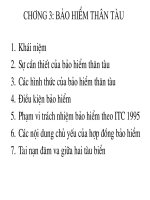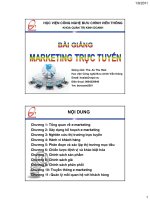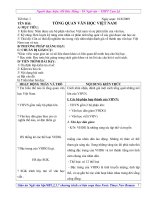Bài giảng MARKETING MANAGEMENT LECTURE NOTES: chap 3 marketing environment analysis
Bạn đang xem bản rút gọn của tài liệu. Xem và tải ngay bản đầy đủ của tài liệu tại đây (310.03 KB, 9 trang )
3/8/2018
Chapter Questions
1
3
Collecting Information
and
Forecasting Demand
What are the components of a modern
marketing information system?
What are useful internal records?
What makes up a marketing intelligence
system?
What are some influential macro
environment developments?
How can companies accurately measure
and forecast demand?
Copyright © 2011 Pearson Education, Inc. Publishing as Prentice Hall
Internal Records and
Marketing Intelligence
What is a
Marketing Information System?
A marketing information system
consists of people, equipment, and
procedures to gather, sort, analyze,
evaluate, and distribute needed, timely,
and accurate information to
marketing decision makers.
Copyright © 2011 Pearson Education, Inc. Publishing as Prentice Hall
3-2
3-3
Order-to-payment cycle
Sales information system
Databases, warehousing, data mining
Marketing intelligence system
Copyright © 2011 Pearson Education, Inc. Publishing as Prentice Hall
3-4
What is a
Marketing Intelligence System?
Database Management
A marketing intelligence system is
a set of procedures and sources
that managers use to obtain
everyday information about
developments in the marketing
environment.
Copyright © 2011 Pearson Education, Inc. Publishing as Prentice Hall
3-5
Copyright © 2011 Pearson Education, Inc. Publishing as Prentice Hall
3-6
1
3/8/2018
Steps to Quality Marketing Intelligence
Train sales force to scan for new developments
Motivate channel members to share intelligence
Hire external experts to collect intelligence
Network externally
Utilize a customer advisory panel
Utilize government data sources
Purchase information
Copyright © 2011 Pearson Education, Inc. Publishing as Prentice Hall
3-7
Sources of Competitive Information
Copyright © 2011 Pearson Education, Inc. Publishing as Prentice Hall
Major Forces in the Environment
Political-legal
Economic
Technological
Socio-cultural
3-8
Population and Demographics
Demographic
Independent customer goods and service
review forums
Distributor or sales agent feedback sites
Combination sites offering customer reviews
and expert opinions
Customer complaint sites
Public blogs
Population growth
Population age mix
Ethnic markets
Educational groups
Household patterns
Natural
Copyright © 2011 Pearson Education, Inc. Publishing as Prentice Hall
3-9
Perspective on the Global
Demographic Environment
Copyright © 2011 Pearson Education, Inc. Publishing as Prentice Hall
3-10
Economic Environment
Consumer Psychology
Income Distribution
Income, Savings, Debt, Credit
Copyright © 2011 Pearson Education, Inc. Publishing as Prentice Hall
3-11
Copyright © 2011 Pearson Education, Inc. Publishing as Prentice Hall
3-12
2
3/8/2018
Economic Environment and
Consumer Psychology
Income Distribution
Subsistence economies
Raw-material-exporting economies
Industrializing economies
Industrial economies
Copyright © 2011 Pearson Education, Inc. Publishing as Prentice Hall
3-13
Copyright © 2011 Pearson Education, Inc. Publishing as Prentice Hall
Table 3.4 Most Popular
American Leisure Activities
Social-Cultural Environment
Views
Views
Views
Views
Views
Views
of themselves
of others
of organizations
of society
of nature
of the universe
Copyright © 2011 Pearson Education, Inc. Publishing as Prentice Hall
3-15
Reading
TV Watching
Spending time with
family
Going to movies
Fishing
Computer activities
Gardening
Renting movies
Walking
Exercise
Copyright © 2011 Pearson Education, Inc. Publishing as Prentice Hall
Socio-Cultural Influences
3-16
Natural Environment
Copyright © 2011 Pearson Education, Inc. Publishing as Prentice Hall
3-14
3-17
Shortage of raw materials
Increased energy costs
Anti-pollution pressures
Governmental protections
Copyright © 2011 Pearson Education, Inc. Publishing as Prentice Hall
3-18
3
3/8/2018
Technological Environment
The Political-Legal Environment
Pace of change
Opportunities for innovation
Varying R&D budgets
Increased regulation of change
Business Legislation
Growth of Special Interest Groups
Copyright © 2011 Pearson Education, Inc. Publishing as Prentice Hall
3-19
Copyright © 2011 Pearson Education, Inc. Publishing as Prentice Hall
Forecasting and
Demand Measurement
3-20
A Vocabulary for
Demand Measurement
How can we measure market demand?
Potential market
Available market
Target market
Penetrated market
Market Demand
Market Forecast
Market Potential
Company Demand
Company Sales Forecast
Company Sales Potential
Copyright © 2011 Pearson Education, Inc. Publishing as Prentice Hall
3-21
Copyright © 2011 Pearson Education, Inc. Publishing as Prentice Hall
Estimating Current Demand:
Total Market Potential
Teenager T Shirt market
Multiple potential number of buyers by average
quantity each purchases times price
Q = n x q x p (*)
Q : total demand
n : Number of buyers
q : average product quantity customer buys
every year
p : average price
Copyright © 2011 Pearson Education, Inc. Publishing as Prentice Hall
3-22
HCMC population: 10 m
Population in Dist. 1, 3, 4, Tân Bình, Phú
Nhuận: 40% HCMC
Teenager makes up 20% population
Teenager often buys 3 items/year
Affordable price: 200.000/item
Calculate the market demand?
Market demand = 10 m x 0.4 x0.2 x3x200000
3-23
4
3/8/2018
Estimating Future Demand
1
Survey of Buyers’ Intentions
Composite of Sales Force Opinions
Expert Opinion
Past-Sales Analysis
Market-Test Method
Copyright © 2011 Pearson Education, Inc. Publishing as Prentice Hall
Conducting
Marketing Research
3-25
What is Marketing Research?
The Marketing Research Process
Marketing research is the systematic design,
collection, analysis, and reporting of data
and findings relevant to a specific marketing
situation facing the company.
Copyright © 2011 Pearson Education, Inc. Publishing as Prentice Hall
4-27
Define the problem
Develop research plan
Collect information
Analyze information
Present findings
Make decision
Copyright © 2011 Pearson Education, Inc. Publishing as Prentice Hall
4-28
Types of Research
Step 1: Define the Problem
Exploratory
Define the problem
Specify decision alternatives
State research objectives
Descriptive
Causal
Copyright © 2011 Pearson Education, Inc. Publishing as Prentice Hall
4-29
Copyright © 2011 Pearson Education, Inc. Publishing as Prentice Hall
4-30
5
3/8/2018
Data sources
Step 2: Develop the Research Plan
Data sources
Research approach
Research instruments
Sampling plan
Contact methods
Copyright © 2011 Pearson Education, Inc. Publishing as Prentice Hall
4-31
Observational and ethnographic
Focus group
Survey
Behavioral
Experimental
Copyright © 2011 Pearson Education, Inc. Publishing as Prentice Hall
4-33
Research Instruments
4-32
Focus Groups
Research Approaches
Copyright © 2011 Pearson Education, Inc. Publishing as Prentice Hall
Copyright © 2011 Pearson Education, Inc. Publishing as Prentice Hall
4-34
Qualitative Techniques
Questionnaires
Qualitative Measures
Technological Devices
Word Associations
Visualization
Projective Techniques
Laddering
Copyright © 2011 Pearson Education, Inc. Publishing as Prentice Hall
4-35
Copyright © 2011 Pearson Education, Inc. Publishing as Prentice Hall
4-36
6
3/8/2018
Questionnaire Do’s and Don’ts
Ensure questions are
free of bias
Make questions simple
Make questions specific
Avoid jargon
Avoid sophisticated
words
Avoid ambiguous words
Question Types - Dichotomous
Avoid negatives
Avoid hypotheticals
Avoid words that could
be misheard
Use response bands
Use mutually exclusive
categories
Allow for “other” in fixed
response questions
Copyright © 2011 Pearson Education, Inc. Publishing as Prentice Hall
4-37
Question Types – Multiple Choice
In arranging this trip, did you contact
American Airlines?
Yes No
Copyright © 2011 Pearson Education, Inc. Publishing as Prentice Hall
Question Types – Likert Scale
No one
Indicate your level of agreement with the
following statement: Small airlines generally
give better service than large ones.
Spouse
Strongly disagree
Spouse and children
Disagree
Children only
Neither agree nor disagree
Business associates/friends/relatives
Agree
An organized tour group
Strongly agree
With whom are you traveling on this trip?
Copyright © 2011 Pearson Education, Inc. Publishing as Prentice Hall
4-39
Question Types –
Semantic Differential
4-38
Copyright © 2011 Pearson Education, Inc. Publishing as Prentice Hall
4-40
Question Types –
Importance Scale
Airline food service is _____ to me.
American Airlines
Large ………………………………...…….Small
Extremely important
Experienced………………….….Inexperienced
Very important
Modern……………………….…..Old-fashioned
Somewhat important
Not very important
Not at all important
Copyright © 2011 Pearson Education, Inc. Publishing as Prentice Hall
4-41
Copyright © 2011 Pearson Education, Inc. Publishing as Prentice Hall
4-42
7
3/8/2018
Question Types –
Intention to Buy Scale
Question Types – Rating Scale
Excellent
How likely are you to purchase tickets on
American Airlines if in-flight Internet access
were available?
Very good
Definitely buy
Good
Probably buy
Fair
Not sure
Poor
Probably not buy
American Airlines’ food service is _____.
Definitely not buy
Copyright © 2011 Pearson Education, Inc. Publishing as Prentice Hall
4-43
Question Types –
Intention to Buy Scale
Copyright © 2011 Pearson Education, Inc. Publishing as Prentice Hall
4-44
Question Types –
Completely Unstructured
How likely are you to purchase tickets on
American Airlines if in-flight Internet access
were available?
What is your opinion of American Airlines?
Definitely buy
Probably buy
Not sure
Probably not buy
Definitely not buy
Copyright © 2011 Pearson Education, Inc. Publishing as Prentice Hall
4-45
Question Types –
Word Association
4-46
Question Types –
Sentence Completion
What is the first word that comes to your mind
when you hear the following?
Airline ________________________
American _____________________
Travel ________________________
Copyright © 2011 Pearson Education, Inc. Publishing as Prentice Hall
Copyright © 2011 Pearson Education, Inc. Publishing as Prentice Hall
4-47
When I choose an airline, the most important
consideration in my decision is:
_____________________________________
_____________________________________
_____________________________________
_____________________________________
_____________________________________
_____________________________________
__________________.
Copyright © 2011 Pearson Education, Inc. Publishing as Prentice Hall
4-48
8
3/8/2018
Question Types –
Story Completion
Technological Devices
“I flew American a few days ago. I noticed
that the exterior and interior of the plane had
very bright colors. This aroused in me the
following thoughts and feelings.” Now
complete the story.
___________________________________
___________________________________
___________________________________
___________________________________
___________________________________
Copyright © 2011 Pearson Education, Inc. Publishing as Prentice Hall
4-49
Sampling Plan
Galvanometers
Tachistoscope
Eye cameras
Audiometers
GPS
Copyright © 2011 Pearson Education, Inc. Publishing as Prentice Hall
4-50
Contact Methods
Sampling unit: Who is to be surveyed?
Sample size: How many people should be
surveyed?
Sampling procedure: How should the
respondents be chosen?
Copyright © 2011 Pearson Education, Inc. Publishing as Prentice Hall
4-51
Copyright © 2011 Pearson Education, Inc. Publishing as Prentice Hall
4-52
Pros and Cons of
Online Research
Advantages
Inexpensive
Fast
Accuracy of data
Versatility
Disadvantages
Small samples
Skewed samples
Technological
problems
Inconsistencies
Copyright © 2011 Pearson Education, Inc. Publishing as Prentice Hall
4-53
9









